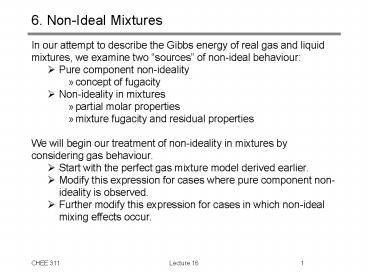6' NonIdeal Mixtures - PowerPoint PPT Presentation
1 / 9
Title:
6' NonIdeal Mixtures
Description:
In cases where molecular interactions differ between the components (polar/non ... We have used the virial equation of state to calculate the fugacity and fugacity ... – PowerPoint PPT presentation
Number of Views:47
Avg rating:3.0/5.0
Title: 6' NonIdeal Mixtures
1
6. Non-Ideal Mixtures
- In our attempt to describe the Gibbs energy of
real gas and liquid mixtures, we examine two
sources of non-ideal behaviour - Pure component non-ideality
- concept of fugacity
- Non-ideality in mixtures
- partial molar properties
- mixture fugacity and residual properties
- We will begin our treatment of non-ideality in
mixtures by considering gas behaviour. - Start with the perfect gas mixture model derived
earlier. - Modify this expression for cases where pure
component non-ideality is observed. - Further modify this expression for cases in which
non-ideal mixing effects occur.
2
Perfect Gas Mixtures
- We examined perfect gas mixtures in lecture 9.
The assumptions made in developing an expression
for the chemical potential of species i in a
perfect gas mixture were - all molecules have negligible volume
- interactions between molecules of any type are
negligible. - Based on this model, the chemical potential of
any component in a perfect gas mixture is - where the reference state, Giig(T,P) is the pure
component Gibbs energy at the given P,T. - We can choose a more convenient reference
pressure that is standard for all fluids, that is
Punit pressure (1 bar,1 psi,etc) - In this case the pure component Gibbs energy
becomes
3
Perfect Gas Mixtures
- Substituting for our new reference state yields
- (11.29)
- which is the chemical potential of component i in
a perfect gas mixture at T,P. - The total Gibbs energy of the perfect gas mixture
is provided by the summability relation - (11.11)
- (11.30)
4
Ideal Mixtures of Real Gases
- One source of mixture non-ideality resides within
the pure components. Consider an ideal solution
that is composed of real gases. - In this case, we acknowledge that molecules have
finite volume and interact, but assume these
interactions are equivalent between components - The appropriate model is that of an ideal
solution - where Gi(T,P) is the Gibbs energy of the real
pure gas - (11.31)
- Our ideal solution model applied to real gases is
therefore
5
Non-Ideal Mixtures of Real Gases
- In cases where molecular interactions differ
between the components (polar/non-polar mixtures)
the ideal solution model does not apply - Our knowledge of pure component fugacity is of
little use in predicting the mixture properties - We require experimental data or correlations
pertaining to the specific mixture of interest - To cope with highly non-ideal gas mixtures, we
define a solution fugacity - (11.47)
- where fi is the fugacity of species i in
solution, which replaces the product yiP in the
perfect gas model, and yifi of the ideal solution
model.
6
Non-Ideal Mixtures of Real Gases
- To describe non-ideal gas mixtures, we define the
solution fugacity - and the fugacity coefficient for species i in
solution - (11.52)
- In terms of the solution fugacity coefficient
- Notation
- fi, ?i - fugacity and fugacity coefficient for
pure species i - fi, ?i - fugacity and fugacity coefficient for
species i in solution
7
Calculating ?iv from Compressibility Data
- Consider a two-component vapour of known
composition at a given pressure and temperature - If we wish to know the chemical potential of each
component, we must calculate their respective
fugacity coefficients - In the laboratory, we could prepare mixtures of
various composition and perform PVT experiments
on each. - For each mixture, the compressibility (Z) of the
gas can be measured from zero pressure to the
given pressure. - For each mixture, an overall fugacity coefficient
can be derived at the given P,T - How do we use this overall fugacity coefficient
to derive the fugacity coefficients of each
component in the mixture?
8
Calculating ?iv from Compressibility Data
- It can be shown that mixture fugacity
coefficients are partial molar properties of the
residual Gibbs energy, and hence partial molar
properties of the overall fugacity coefficient - In terms of our measured compressiblity
9
Calculating ?iv from the Virial EOS
- We have used the virial equation of state to
calculate the fugacity and fugacity coefficient
of pure, non-polar gases at moderate pressures. - Under these conditions, it represents non-ideal
PVT behaviour of pure gases quite accurately - The virial equation can be generalized to
describe the calculation of mixture properties. - The truncated virial equation is the simplest
alternative - where B is a function of temperature and
composition according to - (11.61)
- Bij characterizes binary interactions between i
and j BijBji































